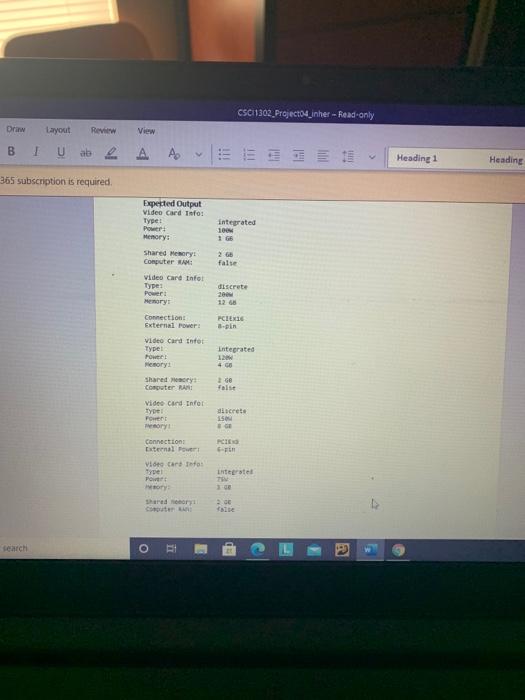CSC1302_Project04_inner - Read-only Review View A A Heading 2 Heading 1 equired Description Modity and update your program from Assignment 3 that defined and tested a Computer class with a VideoCard. For this assignment we'll only use the VideoCard dass. The Video Card class will be extended by the Discrete Video Card and Integrated VideoCard classes. Pay careful attention to any changes within each individual class as classes are different than described in Assignment 3 as well as any changes in the test program. NOTE: For all classes, additional constructors can be added as needed, but must be documented in the UML VideoCard: The Video Card class should contain the following information: type (integrated, discrete, etc.) power requirements (in watts) memory in GB) Include a default constructor A constructor to set the type, power requirements, and memory size of a VideoCard. There should also be a method called toString that returns detailed, formatted information about the Video Card and its current state. By default, a Video Card should be of type "integrated", with a power requirement of 100 watts, and 1GB of memory Error checking should be used on the power requirements to keep them in the range of 1-300w (default 200 if above 300, 75 if below 1), and the memory should be kept between 1-12 GB (default 12 if above 12.1 if below 1). Integrated Video Card: The Integrated video card class is a subclass of VideoCard and should contain data members to represent the amount of shared video memory in watts; Whether or not the card uses the computer's RAM for shared memory A constructor to set the the properties of an integrated videochat All constructors should make sure to set the appropriate type of card O CSC 1302 Projecto4_jnher - Read-only Layout Review View Heading 1 Heading I U ab 2 A Subscription is required There should be a method led toString that returns information from both the Video Card's toString) and detailed information about the integrated videoCard. By default, an integrated Video Card has 2 GB of shared memory and does not need access to the Computer's RAM Discrete Video Card: The DiscretevideoCard class is a subclass of Video Card and should contain data members to represent Motherboard connection type (PCIE, PCB, etc.) External power type (6-pin, 8-pin, dual, etc.) Include a default constructor A constructor to set the properties of a DiscretevideoCard. All constructors should make sure to set the appropriate type of card. There should be a method called toString() that returns information from both the Videocard's toString) and detailed information about the DiscreteVideoCard. By default, a Discrete Video Card has a motherboard connection of PCIEXS and an external power type of 6-pin NOTES: Use appropriate vishility modifiers based on class discussion. Use accessor/mutator methods and the this and super keywords when appropriate UML: Create a simplified UML diagram that describes all classes and their relationships. Include multiplicity for any associations of needed). Include the proper aggregation symbols for the classes. You should provide full details including visibility for each class (all instance members) but can create a separate diagram using simplified class UML to show only the relationships (including inheritance), desired Test Propam Finally, write a test program that generates a computer lab containing a collection of five Computers. For research purposes, two of the machines will have discrete graphics cards, but the other will have integrated cards with varying features. See below for specific Computer and Videocard specifications Video Cards should ONLY be created where appropriate based on ther relationship to Computer 9 CSC1302_Project04_inner - Read-only UW Layout View Heading 1 Heading 2 3 1 Uab 2 A subscription is required Video Card 1: Default Video Card Video Card 2: Discrete Video Card, PCIEX16 motherboard connection, 375W draw, 8-pin external power, 16 GB memory Video Card 3: Integrated video Card, 120W draw, 4 GB memory Videocard 4: Discrete Video Card, PB motherboard connection, 150w draw, 6-pin external power, 8GB memory Video Card 5: Integrated videoCard, 110W draw, 3 GB memory rate the above collection of video cards and using a method that accepts an array of VideoCard, print info about each one to the Console Any out-of-range values should be handled by the dass implementationis not through manual changes to the test program, Expected Output Video card to TYPE integrated 14 Shades Cost aise Vides card to discrete CSC11302 ProjectO4 inher-Readonly Draw View Layout I uab B A A Heading 1 Heading 365 subscription is required. integrated 100 268 false Expected Output Video Card to Type: Power Menory: Shared Memory: Computer AM Video Card Info Type: Power: Memory Connection External Power: Video Card Info Type Power! Mesory: Shared Mary Computer RA discrete 1268 PCIE -pin Integrated 120 Ge False discrete Video Card Info Type: Foment mory Connection External Power Video Card Info: PCIE Interstel Po Oy Shared D O CSC1302_Project04_inner - Read-only Review View A A Heading 2 Heading 1 equired Description Modity and update your program from Assignment 3 that defined and tested a Computer class with a VideoCard. For this assignment we'll only use the VideoCard dass. The Video Card class will be extended by the Discrete Video Card and Integrated VideoCard classes. Pay careful attention to any changes within each individual class as classes are different than described in Assignment 3 as well as any changes in the test program. NOTE: For all classes, additional constructors can be added as needed, but must be documented in the UML VideoCard: The Video Card class should contain the following information: type (integrated, discrete, etc.) power requirements (in watts) memory in GB) Include a default constructor A constructor to set the type, power requirements, and memory size of a VideoCard. There should also be a method called toString that returns detailed, formatted information about the Video Card and its current state. By default, a Video Card should be of type "integrated", with a power requirement of 100 watts, and 1GB of memory Error checking should be used on the power requirements to keep them in the range of 1-300w (default 200 if above 300, 75 if below 1), and the memory should be kept between 1-12 GB (default 12 if above 12.1 if below 1). Integrated Video Card: The Integrated video card class is a subclass of VideoCard and should contain data members to represent the amount of shared video memory in watts; Whether or not the card uses the computer's RAM for shared memory A constructor to set the the properties of an integrated videochat All constructors should make sure to set the appropriate type of card O CSC 1302 Projecto4_jnher - Read-only Layout Review View Heading 1 Heading I U ab 2 A Subscription is required There should be a method led toString that returns information from both the Video Card's toString) and detailed information about the integrated videoCard. By default, an integrated Video Card has 2 GB of shared memory and does not need access to the Computer's RAM Discrete Video Card: The DiscretevideoCard class is a subclass of Video Card and should contain data members to represent Motherboard connection type (PCIE, PCB, etc.) External power type (6-pin, 8-pin, dual, etc.) Include a default constructor A constructor to set the properties of a DiscretevideoCard. All constructors should make sure to set the appropriate type of card. There should be a method called toString() that returns information from both the Videocard's toString) and detailed information about the DiscreteVideoCard. By default, a Discrete Video Card has a motherboard connection of PCIEXS and an external power type of 6-pin NOTES: Use appropriate vishility modifiers based on class discussion. Use accessor/mutator methods and the this and super keywords when appropriate UML: Create a simplified UML diagram that describes all classes and their relationships. Include multiplicity for any associations of needed). Include the proper aggregation symbols for the classes. You should provide full details including visibility for each class (all instance members) but can create a separate diagram using simplified class UML to show only the relationships (including inheritance), desired Test Propam Finally, write a test program that generates a computer lab containing a collection of five Computers. For research purposes, two of the machines will have discrete graphics cards, but the other will have integrated cards with varying features. See below for specific Computer and Videocard specifications Video Cards should ONLY be created where appropriate based on ther relationship to Computer 9 CSC1302_Project04_inner - Read-only UW Layout View Heading 1 Heading 2 3 1 Uab 2 A subscription is required Video Card 1: Default Video Card Video Card 2: Discrete Video Card, PCIEX16 motherboard connection, 375W draw, 8-pin external power, 16 GB memory Video Card 3: Integrated video Card, 120W draw, 4 GB memory Videocard 4: Discrete Video Card, PB motherboard connection, 150w draw, 6-pin external power, 8GB memory Video Card 5: Integrated videoCard, 110W draw, 3 GB memory rate the above collection of video cards and using a method that accepts an array of VideoCard, print info about each one to the Console Any out-of-range values should be handled by the dass implementationis not through manual changes to the test program, Expected Output Video card to TYPE integrated 14 Shades Cost aise Vides card to discrete CSC11302 ProjectO4 inher-Readonly Draw View Layout I uab B A A Heading 1 Heading 365 subscription is required. integrated 100 268 false Expected Output Video Card to Type: Power Menory: Shared Memory: Computer AM Video Card Info Type: Power: Memory Connection External Power: Video Card Info Type Power! Mesory: Shared Mary Computer RA discrete 1268 PCIE -pin Integrated 120 Ge False discrete Video Card Info Type: Foment mory Connection External Power Video Card Info: PCIE Interstel Po Oy Shared D O










